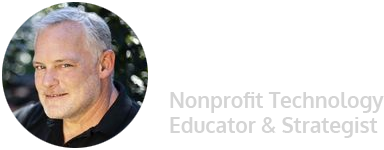The choices you make about technology can make or break your organization. The time for making guesses about your technology choices is over. There are two different paths our sector – and your organization specifically – can choose. One leads to effective technology use, the other does not. Let’s look at what actions organizations can take to use technology effectively. It actually has much more to do with your data than with technology tools.
For nonprofit and nongovernmental organizations, the most important asset in fulfilling their missions, besides their people, is their information. Data is important because organizations use it in everything they do from making a phone call or writing a letter to requesting funding. As the volume of available data grows, locating useful information becomes increasingly difficult. The advantage is going to those organizations who can collect, organize, process and act on that useful information. Working with large volumes of information intelligently requires technology tools that are appropriate for your needs. The increasing volume and importance of information makes Information Technology essential to helping good causes succeed.
What is ”using technology effectively”?
Technology is not an end in itself. Simply having a database, a network and a technology budget does not mean you are using technology effectively. Truly effective use of technology means something different for every organization – only you can say what it means for your organization. The activities detailed below make up a good part of the road to effective use of technology. On the road you will examine what you do, how and even why. You will identify and correct your mistakes and build on your successes.
This is a complex issue, so get help from an expert if there is not one in your organization. There is no substitute for a person who knows how technology tools are being used in nonprofit and nongovernmental organizations. Make sure you have a nonprofit-focused technologist included in all discussions about your data and tools. When someone understands what you want to accomplish and how you plan to accomplish it, they can then suggest tools to help you act faster or more effectively. In technology staff and consultants, our community has a wonderful resource to help them benefit from tools that use technology – take advantage of that.
Here are 10 truths for organizations who want to make effective use of technology tools.
After people, Data is Your Most Important Resource
Act accordingly in planning and allocating resources. For most organizations, staff salaries are the largest budget item. Is Data the second largest? Too infrequently.
Your Results Depend on Your Investment in Data
Dedicate staff time to collecting, maintaining and understanding it. Spend money on finding the right tools for you. The minimum spent on technology tools will get you the minimum impact.
Define and Know Your Data Needs and Uses
Define the data that your organization needs to fulfill its mission. Know where to get the data and specifically which pieces of data are important to you.
Seek out Data and Keep it Flowing
Actively seek out data that could help you succeed – include data on clients, funders, members, donors and employees. Make a concerted, ongoing effort to keep data flowing into your organization and to maintaining that data.
Define Your Needs in Detail BEFORE tool selection
Define and create the best system you can to hold and manipulate your data. DO NOT grab the first tool or software that looks good. Measure twice and cut once goes double – no triple – for technology. If you have tools, regularly review new options.
Honestly Look at Your Information Systems
Take an honest, detailed look at how your systems do – and do not – work. Look at human systems, data systems and communication systems. It is difficult for you to be objective about your organization’s problems, so get an independent opinion – and listen to it.
Maintain Commitment of Board and Staff
Get agreement from staff, management and the board to make an ongoing commitment of resources to improve operations.
Have an Ongoing Conversation about Data
Have an ongoing discussion in the organization about the best ways to use your data, and what you can learn from it. This can be between the ED and the Program manager, or it could be a six-member committee of staff from throughout the organization.
Keep in Touch with Other Organizations
Keep in regular contact with other organizations and the nonprofit technology community in order to keep up to date with tools and solutions. There is no substitute for advice from experience. Seek out organizations of a similar size and mission and share challenges. Don’t continue working in isolation or ignorance.
Knowledge Eases Fear – Gather and Share Knowledge
Identify and confront techno-phobia in all its forms. No matter if it’s the ED, the development director or the administrative assistant – you need everyone pulling in the same direction, not at opposite ends. If you are that person, remember that the cure for fear is knowledge – seek it out.
Since data is essential to the life and success of every nonprofit organization, and the best way to manage data is with tools that use technology, then information technology should be the second most important thing to every organization – and very funder!
This article was first written in 2003 for NTEN. It has had slight revisions to improve clarity, but even after all these years, I believe the ten ideas remain relevant.

Leave a Reply